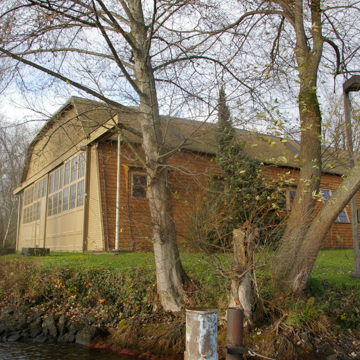You are here
Canoe House
The Canoe House was the third of five buildings to house boats for the University of Washington rowing program, and perhaps its most famous. It was here where George Pocock designed and built wooden boat shells and oars for the University of Washington rowing team, whose eight-man crew won the national collegiate championship in 1923 and captured the gold medal in the 1936 Olympics in Berlin.
The building, however, also retains interest for its architecture. Although used only briefly for its original purpose (it was built by the U.S. Navy as a seaplane hangar during World War I), its expansive interior, with an 88-foot span created by large timber Howe trusses and raked outer walls supporting a gambrel-shaped roof, made it an attractive building for adaptation to other uses. Because of its proximity to Lake Union on the southeasternmost tip of campus, a logical conversion was for boat construction.
Beginning in 1922, the university began remodeling the building for the rowing team by walling off the building’s northern end and creating a second floor that could be accessed by an exterior stair. It was on the second floor—a 70-foot-long and 20-foot-wide space—where Pocock and his crew began construction of the fast, 61-foot boat shells from western red cedar that would soon revolutionize the world of intercollegiate boat racing. Beyond these slight modifications, most of the features in the Canoe House were retained: then as now, the building is clad with shingles and the long walls contain double-hung sash windows. The southern end contains a three-section sliding door, with outriggers enabling the door to slide clear of the opening, from which boats could be easily slid into the water.
Rowing at the University of Washington had begun as early as 1901, and by 1903 the team won the Pacific Coast Championship. Hiram Conibear was the founder of the team and operated out of a boathouse quite close to the current Conibear Shellhouse (2005, Miller Hull Partnership), but by the time the team moved into the Canoe House in 1922, Rusty Callow had assumed the coaching duties. Between 1922 and 1927 the team won three intercollegiate rowing association championships and was the first west coast team to win the Hudson River Classic. It was under coach Al Ulbrickson that the team won the Olympic Gold at the Berlin games (a story immortalized in Daniel James Brown’s 2014 bestseller The Boys in the Boat) and the team won the gold again at the London games of 1948.
In 1949, the crew team moved its facility to a new structure northward along Union Bay, and the university converted the building for boat storage and rental—a role it has served for more than 65 years, although for a period it was in service as a boathouse for the university’s sailing club. The U.S. Army Corps of Engineers, which owned the building at one time, relinquished its ownership in 1965. The building is today part of the University of Washington. The legacy of the Canoe House—and that for which it earned a listing on the National Register of Historic Places in 1975—remains its association with the boat-building operation that Pocock orchestrated from this location.
Writing Credits
If SAH Archipedia has been useful to you, please consider supporting it.
SAH Archipedia tells the story of the United States through its buildings, landscapes, and cities. This freely available resource empowers the public with authoritative knowledge that deepens their understanding and appreciation of the built environment. But the Society of Architectural Historians, which created SAH Archipedia with University of Virginia Press, needs your support to maintain the high-caliber research, writing, photography, cartography, editing, design, and programming that make SAH Archipedia a trusted online resource available to all who value the history of place, heritage tourism, and learning.






